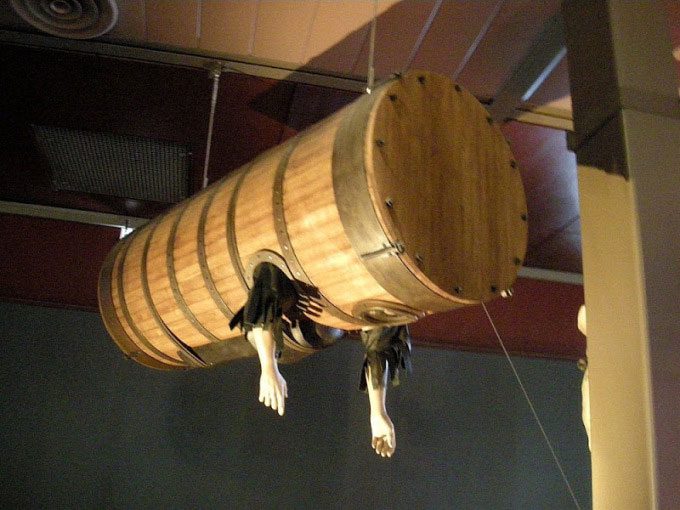From a failed merchant, John Lethbridge became wealthy with his invention of a diving suit that allows for deep dives of approximately 20 meters.
The Cité de la Mer Museum in Cherbourg, France, displays a strange object resembling a medieval torture device, which is actually a replica of the world’s first airtight diving suit. The inventor of the suit, John Lethbridge (1675 – 1759), was a wool merchant from Newton Abbot, Devon, England. There is not much information about his childhood or what inspired him to create the diving suit. According to BBC, he had up to 17 children, which drove him to work hard for financial stability.

Replica of John Lethbridge’s diving suit at the Cité de la Mer museum, Cherbourg, France. (Photo: Ji-Elle)
Before Lethbridge’s invention, diving was performed using a “diving bell” – a device resembling an inverted cup or bell without a pendulum, lowered into the water so that the person inside could breathe the trapped air. Divers could exit through the bottom to perform tasks and then return inside the bell.
In 1715, John Lethbridge became the first person to design a functional airtight diving suit, which he called “the diving machine.” The suit resembled a wooden barrel about 1.8 meters long, with the diver lying face down inside. It featured a round window for observation and two openings for arms to extend outside. Two oil-soaked leather tubes wrapped around the upper arms created a nearly waterproof seal.
The diving suit had no air supply except for the trapped air inside before it was sealed. Although it may not sound like much, this air was sufficient for Lethbridge to dive underwater for about 30 minutes at a time. The suit had two air valves at the top. Fresh air could be pumped in through tubes connected to the valves when the diver surfaced. The suit was lowered and raised by cables, but Lethbridge also provided weights that divers could drop to surface without assistance.
Lethbridge hoped his device could reach great depths. However, during testing, he discovered that water pressure at depths beyond 15 meters caused leaks around the arm tubes, window, and entry point. He found that he could still easily dive to 18 meters. The maximum depth was 22 meters, but diving to that depth proved challenging.
Despite these limitations, Lethbridge effectively used the suit in the waters off England and other parts of the Atlantic to recover valuable cargo from shipwrecks. Many shipping companies in London quickly noticed Lethbridge and hired him for salvage work.
In 1794, while traveling from the Netherlands to Java, the Slotter Hooge ship of the Dutch East India Company sank due to strong winds near Porto Santo, Madeira. Of the 254 people on board, only 33 survived. The ship sank at a depth of about 18 meters, carrying 3 tons of silver bars and 3 large chests of coins. Lethbridge was hired for a salary of £10 a month, plus expenses and bonuses. In his first attempt, Lethbridge recovered 349 silver bars, over 9,000 coins, and two guns. Throughout that summer, he made several dives to the wreck and recovered nearly half of the treasure.
Over the next 30 years, Lethbridge worked on many shipwrecks and earned a substantial fortune. From a struggling wool merchant trying to support his family, Lethbridge became wealthy, owning the Odicknoll estate in Kingskerswell.
The original diving suit of Lethbridge no longer exists, but drawings of it are still preserved. Based on these, experts have created several replicas displayed in maritime museums around the world, including one in his hometown of Newton Abbot.



















































